Hurricane Beryl’s Current Path and Predictions

Where is hurricane beryl headed – Hurricane Beryl, a powerful storm, has developed and is currently located over the Atlantic Ocean. The storm is expected to continue moving northwest, with potential landfall predicted along the southeastern coast of the United States.
Hurricane Beryl is currently heading towards the northwest, and is expected to pass near Jamaica. For more information on the hurricane’s path and potential impact on Jamaica, please visit the jamaica hurricane website. Once it passes Jamaica, Hurricane Beryl is expected to continue moving northwest towards the Bahamas.
According to the National Hurricane Center (NHC), Beryl is currently a Category 1 hurricane, with maximum sustained winds of 75 mph. The storm is expected to intensify in the coming days, potentially reaching Category 3 status by the time it approaches the coast.
Currently tracking in the Atlantic Ocean, Hurricane Beryl’s projected path is still uncertain. To stay up-to-date on its potential trajectory, meteorologists rely on beryl spaghetti models , which provide probabilistic forecasts based on numerous computer simulations. By analyzing these models, experts can assess the range of possible paths and likelihood of landfall, helping communities prepare accordingly.
Forecasted Track and Potential Landfall
The NHC has issued a hurricane watch for the coast of Florida, from Jupiter Inlet to the Suwannee River. The storm is expected to make landfall somewhere along this stretch of coastline on Tuesday night or Wednesday morning.
The exact location of landfall is still uncertain, as the storm’s track could shift slightly in the coming days. However, residents in the affected areas should be prepared for the possibility of hurricane-force winds, heavy rain, and flooding.
Expected Impact
Hurricane Beryl is expected to bring heavy rain to the southeastern United States, with some areas receiving up to 10 inches of rainfall. The storm could also produce storm surges of up to 6 feet along the coast, leading to flooding in low-lying areas.
Winds from Hurricane Beryl could reach speeds of up to 120 mph, causing significant damage to buildings, trees, and power lines. Residents in the affected areas should take precautions to secure their property and prepare for potential power outages.
Evacuation Zones and Safety Measures: Where Is Hurricane Beryl Headed

As Hurricane Beryl approaches, local authorities have identified areas that may be impacted by the storm. Residents in these areas are urged to evacuate immediately and follow the designated evacuation routes.
Evacuation zones are typically determined based on factors such as storm surge risk, flooding potential, and wind speed. Residents can check with their local government or emergency management agency to determine if they are in an evacuation zone.
Safety Guidelines, Where is hurricane beryl headed
- Evacuate early: Do not wait until the last minute to evacuate. Leave as soon as possible to avoid getting caught in traffic or dangerous conditions.
- Follow designated evacuation routes: Do not take shortcuts or unfamiliar roads. Evacuation routes are designed to avoid flooded areas and other hazards.
- Bring essential supplies: Pack a bag with essential supplies, including food, water, medications, first aid kit, and important documents.
- Stay informed: Monitor local news and weather reports for updates on the storm’s path and intensity.
- Be prepared for power outages: Have a battery-powered radio and flashlights on hand in case of power outages.
Role of Local Authorities and Emergency Response Teams
Local authorities and emergency response teams play a critical role in managing hurricane evacuations and ensuring the safety of residents. They are responsible for:
- Issuing evacuation orders: Local authorities determine when and where evacuations are necessary based on the storm’s path and intensity.
- Establishing evacuation routes: Emergency response teams work with local authorities to identify and establish safe evacuation routes.
- Providing transportation assistance: For residents who do not have access to transportation, emergency response teams may provide buses or other transportation assistance.
- Setting up shelters: Emergency response teams set up shelters in safe areas where evacuees can stay until the storm passes.
- Coordinating with other agencies: Local authorities and emergency response teams coordinate with other agencies, such as the National Weather Service, to ensure a coordinated response to the hurricane.
Tracking and Monitoring Hurricane Beryl
Hurricane Beryl is being closely monitored by weather experts using a combination of technologies. These include satellites, weather buoys, and aircraft reconnaissance. Satellites provide images of the hurricane from space, which can be used to track its movement and intensity. Weather buoys collect data on wind speed, wave height, and atmospheric pressure, which can help to forecast the hurricane’s path. Aircraft reconnaissance missions are flown into the hurricane to collect data on its structure and intensity.
Real-Time Updates
There are a number of resources available for real-time updates on Hurricane Beryl’s progress. These include the National Hurricane Center website, the Weather Channel website, and the AccuWeather website. There are also a number of mobile applications that can provide real-time updates on the hurricane’s progress. These applications include the National Hurricane Center app, the Weather Channel app, and the AccuWeather app.
Staying Informed
It is important to stay informed about Hurricane Beryl’s progress, especially if you live in an area that could be affected by the hurricane. You can stay informed by checking the National Hurricane Center website, the Weather Channel website, or the AccuWeather website. You can also sign up for alerts from the National Weather Service. These alerts will provide you with the latest information on the hurricane’s progress and any potential threats.